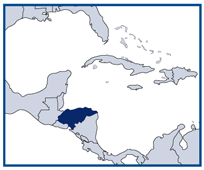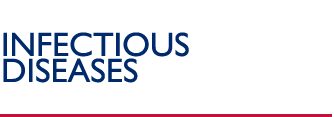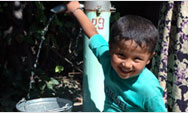Honduras

|
| |
Honduras has the eighth highest tuberculosis burden among Western Hemisphere countries. According to the World Health Organization (WHO) Global TB Report 2006, there were over 5,000 TB cases in the country in 2004, with an estimated incidence rate of 77 cases per 100,000 people. According to national TB program statistics, in 2004 there were 3,332 cases. The estimated rate of new sputum smear-positive (SS+) cases was 29 per 100,000 people. TB is a serious problem in Honduran prisons, where the incidence rate is 18 times higher than in the general population. The Honduras National TB Control Program (NTP) began pilot activities using Directly Observed Therapy, Short-Course (DOTS) in 1998. By 2001, the NTP reported 100 percent DOTS coverage and achieved a treatment success rate of 86 percent, a marked improvement from 75 percent in 1998. TB in Honduras is in part fueled by HIV/AIDS, which has an estimated prevalence of 2 percent among adults, and approximately 10 percent of TB patients have HIV/AIDS.
 |
Note: All data are for 2004 except where noted otherwise. Source: Global Tuberculosis Control: WHO Report 2006. |
USAID Approach and Key Activities
Between 2000 and 2005, USAID funds for TB programming in Honduras averaged $406,000 per year. USAID supports the Ministry of Health (MOH) at the national, department (state), and local levels. USAID assistance targets the following activities and interventions:
- Facilitating DOTS training for MOH personnel and other providers
- Supplying sputum cups
- Providing monitoring and supervision
- Supporting information, education, and communication activities
USAID Program Achievements
USAID support in Honduras, which began in 1998, has produced one of the best TB programs in the region, with DOTS available in all public sector facilities. Since 2003, TB patient identification has intensified with a doubling of sputum tests, indicating the program's positive impact on reducing the TB burden.
USAID's TB program in Honduras has contributed to the following improvements in the implementation of DOTS:
- Increased the cure rate to 87 percent in 2003, exceeding the international target of 85 percent and achieved patient dropout rates below the 5 percent target (according to the NTP, the cure rate in 2005 was 85 percent)
- Decreased the number of new cases from 3,332 cases in 2004 to 2,850 in 2005, a good indication that DOTS is beginning to reduce the prevalence of TB
- Provided DOTS training for more than 7,200 doctors, nurses, laboratory technicians, and other personnel
Case Detection and Treatment Success Rates Under DOTS
 |
Note: DOTS treatment success rate for 2004 will be reported in the 2007 global report.
Source: Global Tuberculosis Control: WHO Report 2006. |
Partnerships
The Ministry of Health is USAID's principal partner. Other important technical assistance partners are Management Sciences for Health, which implements the Rational Pharmaceutical Managementplus project (managing TB drug systems), the Gorgas Memorial Institute (extending DOTS to prisons), and the International Union Against Tuberculosis and Lung Diseases (capacity building and introducing DOTS into medical and nursing curricula).
September 2006
Related Links
|


